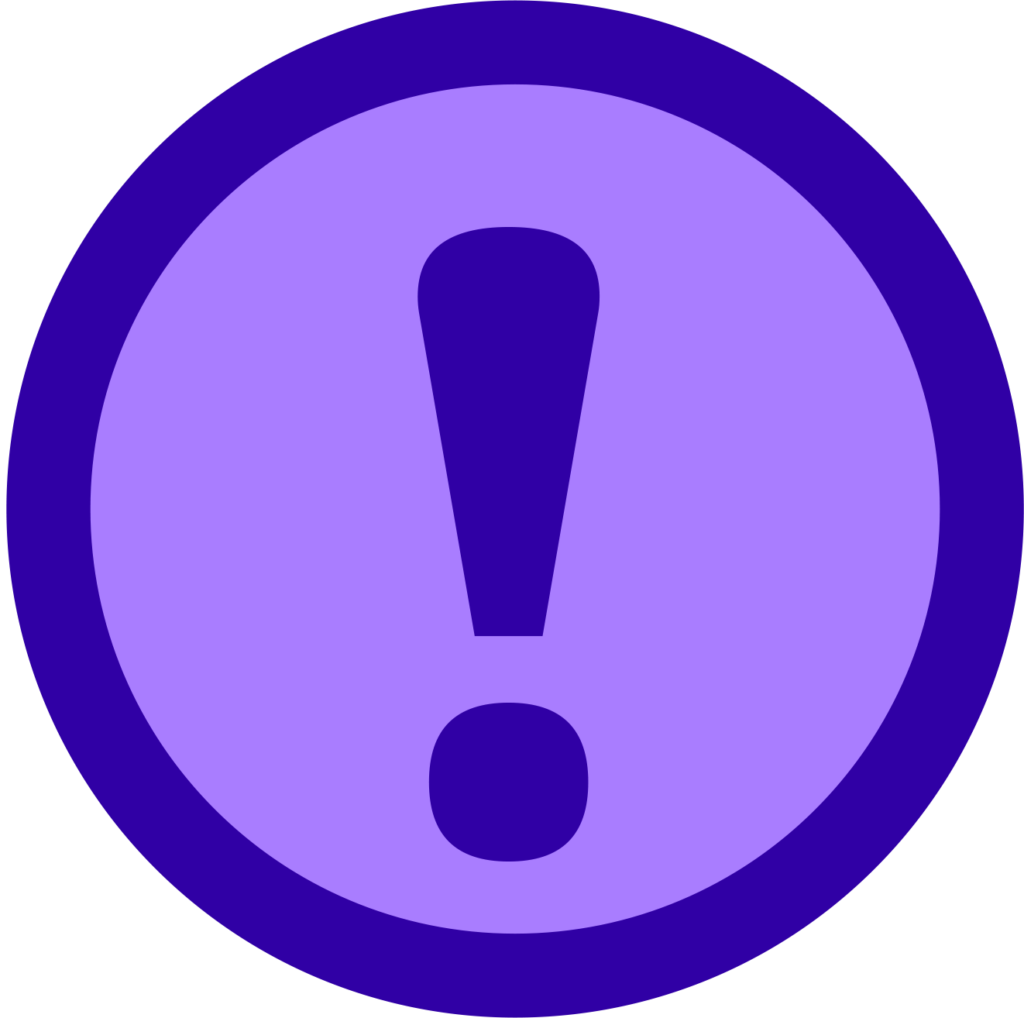Learning Objectives
- Demonstrate the proper use of periods, question marks, and exclamation points

Figure 1. A period is one of the three possible punctuation marks at the end of a sentence.
There are three punctuation marks that come at the end of a sentence: the period ( . ), the question mark ( ? ), and the exclamation point ( ! ).
Periods
Periods are by far the most common ending punctuation mark. They’re at the end of every sentence on this page so far. They occur at the end of statements.
Question Marks

Figure 2. Ensure that you identify whether a question is direct or indirect- it will affect the punctuation.
A question mark comes at the end of a direct question. (How was class today?). Even if the question is rhetorical, and asked to make a point, we use a question mark when an answer is not expected. (Why does it always have to rain on the first day of class?)
Indirect Questions
Indirect questions do not have question marks at their ends. They emphasize uncertainty or lack of knowledge:
- I can’t guess how Tamika managed it.
- I wonder whether I looked that bad.
- Cecil asked where the reports were.
Notice that direct questions imply a question but do not directly ask a question. That’s why they are called indirect questions and do not use a question mark.
What about when you have a sentence that is part statement and part question? What do you do then? You have a couple of options, depending upon the situation. You might have a sentence like this:
- The question I have is, how are we going to get out of here?
In this case, the statement before the question isn’t complete, so you can simply use a comma to separate the statement from the question.
Of course, the sample sentence is a bit awkward, so it might be preferable to rewrite the sentence. You could change the sentence so the first part, the statement part, is a complete sentence. In this situation, you might have a sentence like the following:
- One question remains: How are we going to get out of here?
Exclamation Points

Figure 3. Always carefully review your use of exclamation marks- they are generally an informal punctuation mark that is frequently overused.
The exclamation point is a punctuation mark usually used after an interjection or exclamation to indicate strong feelings or high volume.
A sentence ending in an exclamation mark may be an exclamation (such as “Wow!” or “Boo!”), or an imperative (“Stop!”), or it may indicate astonishment: “They were the footprints of a gigantic duck!”
The exclamation point is sometimes used in conjunction with the question mark to convey protest or astonishment (“Of all the coffee shops, you want to meet at the Pied Cow?!”).
Exclamation points may be repeated for additional emphasis (“That’s great!!!”), but this practice is generally appropriate only in casual or informal writing, such as text messaging or online communication with friends and family.
In most cases, you should be careful with exclamation marks and make sure the situation calls for them. They are generally considered pretty informal, and a particularly famous writer had this to say about them:
Cut out all these exclamation points. An exclamation point is like laughing at your own joke.
— F. Scott Fitzgerald, author of The Great Gatsby
Try It
Punctuation Clusters
Occasionally, you’ll encounter cases that seem to require multiple punctuation marks right next to each other. What should you do? In general, you should not use more than one ending punctuation mark (period, question mark, exclamation point) in a row.
If you are quoting a question, it should end with a question mark, not a question mark and a period. If an abbreviation, like etc., ends a sentence, you should use only one period.
- Carlos leaned forward and asked, “Did you get the answer to number six?”
- I think we’ll have enough food. Mary bought the whole store: chips, soda, candy, cereal, etc.
However, you can place a comma immediately after a period, as you can see in the paragraph above with etc.
If an abbreviation, like etc., ends a sentence, you should use only one period.
This rule also applies to the abbreviations e.g. and i.e.
Periods and parentheses can also appear right next to each other.
Sometimes the period comes after the closing parenthesis when what is inside the parenthesis is not a complete and independent sentence.
I have always wanted to travel to Cuba (although the only city I know of is Havana).
Sometimes the period appears inside the parentheses when what is inside the parenthesis is a full sentence. Notice in this case that the sentence inside the parenthesis is also capitalized.
I am going on a trip to Cuba next week. (My father always wanted to go there.)
Try It
Candela Citations
- Text: Periods, Text: Punctuation Clusters. Authored by: Lumen Learning. License: CC BY: Attribution
- Original Icons. Provided by: Lumen Learning. License: CC BY: Attribution
- Revision and Adaptation of Wikipedia content. Provided by: Lumen Learning. License: CC BY-SA: Attribution-ShareAlike
- Question. Provided by: Wikipedia. Located at: https://en.wikipedia.org/wiki/Question. License: CC BY-SA: Attribution-ShareAlike
- Content clause. Provided by: Wikipedia. Located at: https://en.wikipedia.org/wiki/Content_clause#Interrogative_content_clauses. License: CC BY-NC-SA: Attribution-NonCommercial-ShareAlike
- Exclamation mark. Provided by: Wikipedia. Located at: https://en.wikipedia.org/wiki/Exclamation_mark. License: CC BY-SA: Attribution-ShareAlike
- Modification of Potoooooooo (errors added). Provided by: Wikipedia. Located at: https://en.wikipedia.org/wiki/Potoooooooo. License: CC BY-SA: Attribution-ShareAlike
- Part questions. Authored by: Excelsior OWL. Located at: https://owl.excelsior.edu/grammar-essentials/punctuation/question-marks/. License: CC BY: Attribution
- Exclamation Marks. Authored by: Excelsior OWL. Located at: https://owl.excelsior.edu/grammar-essentials/punctuation/exclamation-marks/. License: CC BY: Attribution
